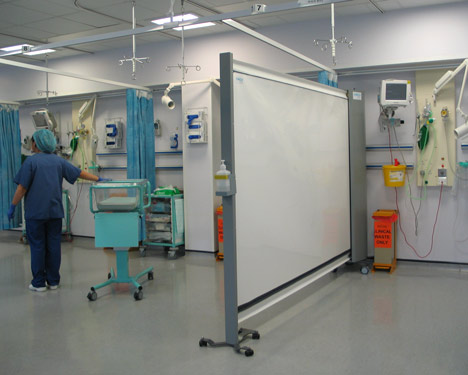
UK James Dyson Award winner announced
Dezeen Wire: a retractable room divider for hospital wards by Royal College of Art graduate Michael Korn has won the UK James Dyson Award.
KwickScreen is a portable, retractable screen that enables hospital staff to quickly isolate infected patients, provide privacy or reconfigure the ward.

The James Dyson Award is an international student design competition running in 18 countries. As a national winner Korn receives £1000 and will go forward with the other seven shortlisted projects from the UK to compete for the International James Dyson Award, worth £10,000 for the winning student or team and £10,000 for their university department.
You can see the winners from the other regions and all the shortlisted designs on the James Dyson Award website.
See all our stories about health here and all our hospital stories here.
Here is some more information from the award organisers:
KwickScreen: UK winner of the James Dyson Award could be ‘rolled-out’ across the NHS.
A portable, retractable room divider has won the UK leg of the James Dyson Award. The KwickScreen means healthcare professionals can make the best use of available space; giving maximum privacy, dignity and protection to patients.
Michael Korn, a student at James Dyson’s alma mater, the Royal College of Art, explored the use bistable materials such as slap on bracelets and tape measures. He developed early prototypes drawing on concepts found in nature, including the Venus fly trap and a frog’s tongue. The discovery of RolaTube Technology gave him the idea of a retractable room divider. He now has exclusive rights to the use the technology for the production of screens and has a patent on the KwickScreen.
The judges agreed that the project was inventive in its simplicity and had commercial potential. Sebastian Conran commented:
“This is such a simple idea, using a well-proven mechanical principle in a unique and innovative way, which seems to have endless applications in a variety of different fields - I just wish I’d thought of it.”
Kwickscreen will progress to compete against leading innovations from the 18 other participating countries. The international winner will be selected by James Dyson and announced on 8th November 2011.
Michael commented: “Winning the UK James Dyson award will propel us towards our goal of increasing exports. The money will go directly towards the first pay packet for our new graduate engineer recruit who is working hard on R&D to develop the next iteration of KwickScreen."
About the KwickScreen
The KwickScreen is manufactured in Corby in the Midlands, using primarily British components. Since its launch 8 months ago the device has been sold to over 25 NHS Trusts as well as hospitals in Italy, Canada and UAE. By next year it is hoped that 25% of sales will come from exports.
Having recently been named as a Royal Commission for the Exhibition of 1851 Research Fellow, Michael will use the £1000 of prize money to help with the further development of his invention.
The Runners-up
The judges selected seven more entries to go through to the award’s international stage:
Flexi- a low cost water pump for the developing world
Problem: Roughly 1 billion people lack access to safe water; they often have to rely on walking miles to collect water from contaminated above ground water sources. Standard pumps are prone to failure and are difficult to repair.
Solution: The Flexi-Pipe Pump is a simple, reliable and low cost water pump. The pump makes use of commonly found materials: a simple bicycle pump produces the compressed air required.
Curve – an ergonomic bike seat for women
Problem: Standard bike saddles create pain and pressure for women at the nose of the saddle as their pelvis tilts forward slightly more than the male.
Solution: Curve is shaped to compliment the shape of the female’s pelvis and supports their weight greatly improving comfort.
Dots – the natural running shoe
Problem: 80% of runners land on their heels relying on a cushion in their running shoes to absorb up to three times their body weight. This can lead to long-term damage such as the "runner's knee" or "shin splint."
Solution: Dots has a patented sole is made of thin layers of colour dots which through controlled erosion produce a unique pattern allowing the runner to watch his running technique and reduce the impact on pressure points such as at the heel of the foot.
OBUOY – an inflatable water rescue device
Problem: 1 million people are rescued by a lifeguard each year. However current products on the market have failings.
Solution: OBUOY is a new inflatable water rescue device that secures a drowning casualty and keeps them afloat, regardless of whether they are able to support themselves. The hinge allows the arms to curl inwards and grab the casualty, keeping their airway above water. It can also be used, once the casualty has been rescued, for oxygen revival which is contained within the aid.
AudioWeb – making websites accessible to the blind
Problem: The internet today is largely visual: rich texts, graphics, images, layouts and video which can pose difficult for the blind. Currently a program called screenreader helps by reading all the text on a page, however this is only frustrating, confusing and extremely slow for a user.
Solution: AudioWeb is a working, fully interactive prototype for the blind by using multiple voices to reflect text formatting, and music. It was developed and tested with real people who have a range of visual impairments and is hugely an improvement from its predecessor.
Air Massage – massaging for arthritics hands
Problem: For Arthritis sufferers, everyday tasks can be extremely frustrating. One in five of the adult population has Arthritis and 10,000,000 people in the U.K alone are sufferers.
Solution: The device uses a number of PVC air bags that fill simultaneously to create a wave of pressure across the hand. Creating compression & massage both beneficial for arthritis. The unit also utilizes an infrared heat pad to give deep penetrative heat into the joints to aid movement.
Suppostin – bowl stimulator for spinal cord injury suffers
Problem: About 95% of people who suffer from Spinal Cord Injury require at least one intervention to initiate defecation. The insertion of suppository and digital bowel stimulation are two common processes in SCI patients’ bowel management program.
Solution: By using Suppostin suppository inserter and Supostin bowel stimulator, users can be more independent and dignified in their bowel care using a simple silicon structure which is lighter and easier to use.

Back to Dezeenwire »
Back to Dezeen »